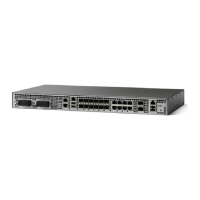The use of a 127.x .y .z address as a destination address of the User Datagram Protocol (UDP) packet is
significant in that the MPLS echo request packet fails to make it to the target device if a transit device does
not label switch the LSP. This allows for the detection of LSP breakages.
•
If an LSP breakage occurs at a transit device, the MPLS echo packet is not forwarded, but consumed
by the device.
•
If the LSP is intact, the MPLS echo packet reaches the target device and is processed by the terminal
point of the LSP.
The figure below shows the path of the MPLS echo request and reply when a transit device fails to label
switch a packet in an LSP.
Figure 9: Path When Transit Device Fails to Label Switch a Packet
An Any Transport over MPLS (AToM) payload does not contain usable forwarding information at a transit
device because the payload might not be an IP packet. An MPLS virtual private network (VPN) packet,
although an IP packet, does not contain usable forwarding information at a transit device because the
destination IP address is only significant to the virtual routing and forwarding (VRF) instances at the
endpoints of the MPLS network.
Note
Information Provided by the Device Processing LSP Ping or LSP Traceroute
The table below describes the characters that the device processing an LSP ping or LSP traceroute packet
returns to the sender about the failure or success of the request.
You can also view the return code for an MPLS LSP Ping operation if you enter the ping mpls verbose
command.
Table 13: LSP Ping and Traceroute Reply Characters
MeaningCharacter
A timeout occurs before the target device can reply.
Period “.”
The target device is unreachable.U
MPLS Basic Configuration Guide, Cisco IOS XE Everest 16.5.1 (Cisco ASR 900 Series)
82
MPLS LSP Ping, Traceroute, and AToM VCCV
Information Provided by the Device Processing LSP Ping or LSP Traceroute

